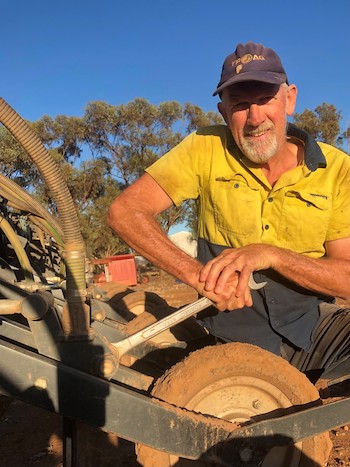Snapshot
Growers: Barry and Kristina Mudge, Jonathon Mudge
Location: Port Germein, South Australia
Property size: 1900 hectares (1600ha owned, 300ha leased)
Area cropped: 1400ha
Enterprises: mixed cropping (lentils, wheat, barley) and livestock (sheep)
Soil types: sand through to loamy Mallee to clay loam
Soil pH: 8.0 to 5.0
Average annual rainfall: 320 millimetres (highly variable year to year).
Barry Mudge is a relatively recent convert to lentils, growing his first successful crop in 2016. Since then, he has steadily expanded the area sown to lentils annually.
“We were lentil-growing novices in 2016,” he says. “There were a number of other growers in the same boat, but with support from GRDC we implemented a pulse extension program, which helped kick things off.”
In 2022, lentils made up approximately 40 per cent of the Mudges’ cropping rotation – mostly small red lentils (previously referred to as Nipper type), along with some large red lentils (previously referred to as PBA Jumbo type). Wheat (40 per cent) and barley (20 per cent) constitute the remainder.
“We now maximise lentils wherever we can,” Barry says.
“On our best country, we’re trying a wheat/lentil rotation, though it has been a challenge to keep broadleaf weeds out of the lentils.”
With its typically warm winters and absence of frost, Barry’s farm at Port Germein, located about 220 kilometres north of Adelaide near the top of Spencer Gulf, is well-suited to lentils. Even in less-than-ideal years they can withstand poor conditions and remain profitable.
Potentially spectacular margins
Barry describes the gross margin from lentils as “spectacular” in a good year. “Nothing else comes close when high prices and good yields combine,” he says.
His first crop in 2016 thrived on the back of a wet spring – something he has not enjoyed again until 2022. However, Barry has still found that lentils have the ability to access deep moisture in the absence of optimal rainfall. Their good biomass in concert with early sowing and mild winters also aids in harvesting.
As well as being profitable in their own right, pulses make an excellent break crop for cereals, retaining some moisture in the soil and increasing soil nitrogen.
Barry’s progress since 2016 has involved a lot of trial and error and associated modifications in response to the challenges that any new crop will throw up.
These include weed control, with the region’s lighter soils limiting growers’ ability to use certain herbicides without incurring significant crop damage. This has been an issue for Emex species (three-corner jacks) and capeweed in particular.
Barry points out that these limited weed-control options prevent him from pushing the crop as hard as he would like to.
“This means we sometimes need to rotate back cereals longer than preferred, so we can drive the weed seedbank down to levels where we can sow lentils again,” he says.
 Barry Mudge on his property near Port Germein, South Australia. Photo: Courtesy Barry Mudge
Barry Mudge on his property near Port Germein, South Australia. Photo: Courtesy Barry Mudge
The move to lentils has also identified a problem with long-term soil acidification. The Mudge team has managed this by mapping soil pH and implementing a liming program on the worst-affected soils.
Barry cautions that lentils can be a more technically demanding crop to grow than cereals, so there is no cutting corners and knowledge is key.
He encourages other growers to arm themselves with information or engage a consultant with pulse expertise. With that in mind, they can play an excellent role in rotations.
“There’s no reason to be afraid of them,” he says. “Our average gross margin for lentils is better than it is for cereals.”
Where and how growers and advisers are adopting pulses into their rotation is a focus of the GRDC investment ‘Development and extension to close the economic yield gap and maximise faming systems benefits from grain legume production in South Australia’.
Project coordinator Sarah Day, from the South Australian Research and Development Institute (SARDI), says they are exploring the economic impact of various management options for grain legume crops, including diseases, weeds and herbicide use.
“Other areas of focus are soil amelioration – including deep ripping – and reducing pod loss,” Ms Day says.
“There are also some lentil and field pea variety trials at some locations to increase the understanding of how these cultivars are adapted to expanding areas.”
Ms Day says most of the trials sown as part of this investment revolve around lentils; however,chickpeas, faba beans, field peas and vetch are represented, as well as cereals for benchmarking purposes.
The project’s contributing research organisations are the University of Adelaide and SARDI. Key collaborators for the SA project are Frontier Farming Systems, EPAG Research, FAR Australia and Trengove Consulting. Affiliated communication and extension partners are Ag Innovation and Research Eyre Peninsula, Upper North Farming Systems, Hart Field-Site Group, Mid North High Rainfall Zone Group, Mallee Sustainable Farming and AgCommunicators.
More information: Barry Mudge, 0417 826 790, theoaks5@bigpond.com; PIRSA media, PIRSA.Media@sa.gov.au

























































